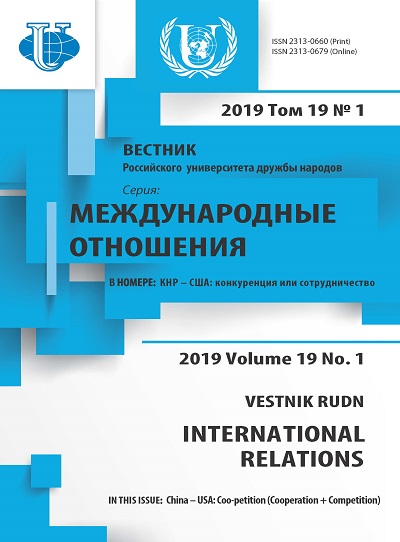Western Europe through the Eyes of Students of Kazakhstan Universities: Countries’ Images and Driving Force for their Formation
- 作者: Yessimova A.B.1, Panarin S.A.2
-
隶属关系:
- South-Kazakhstan State Pedagogical University
- Institute of Oriental Studies, Russian Academy of Sciences
- 期: 卷 19, 编号 1 (2019): China — USA: Coo-petition (Cooperation + Competition)
- 页面: 100-118
- 栏目: 应用分析
- URL: https://journals.rudn.ru/international-relations/article/view/20855
- DOI: https://doi.org/10.22363/2313-0660-2019-19-1-100-118
- ID: 20855
如何引用文章
全文:
详细
The image of a country, and especially how the country is viewed from beyond its borders, is becoming an increasingly important resource capable of exerting positive or negative influence in various fields, including international relations. In the USSR, Western Europe was endowed with a dual image of cultural treasury and the territory dominated by classes and forces hostile to the socialist camp. After the collapse of the USSR, Western Europe began to be perceived as a capitalist model to be coped, and it is from those years that the contemporary ideas of the youth in Kazakhstan about its image have being originated. In order to probe them, a pilot sociological survey was conducted in two Kazakhstani universities, one of which is located in the north-east of the country, in the city of Ust’-Kamenogorsk, the second is in the south, in Shymkent. The results obtained allow us to assert with confidence that students do not have a holistic image of Western Europe; their views are dominated by images of individual European countries, and these images differ greatly in the degree of completeness. The most developed images are those of France and Germany, but even they represent no more than a set of widespread stereotypes about the economic, political, cultural characteristics of both countries. It is also striking that the images of Western European countries, which emerge from the students’ answers, are generally deprived of any meaningful and easily recognizable embodiment, i.e. they are very rarely identified with historically, politically and culturally significant personalities. According to the authors, this feature indicates that students view Western Europe most and foremost as a place where their various consumer needs can be satisfied.
作者简介
Aigul’ Yessimova
South-Kazakhstan State Pedagogical University
编辑信件的主要联系方式.
Email: ayessimova@gmail.com
PhD in History, Associate Professor in Sociology, South-Kazakhstan State Pedagogical University, Shymkent, Kazakhstan
Sergei Panarin
Institute of Oriental Studies, Russian Academy of Sciences
Email: sergpanar@mail.ru
PhD in History, Head of the Department for the Study of Contemporary East, Institute of Oriental Studies, Russian Academy of Sciences
参考
- Adam, F., Hafner-Fink, M. & Uhan, S. (2002). Public Conceptions and Images of the European Union: The Case of Slovenia. Innovation: The European Journal of Social Science Research, 15 (2), 133-147. DOI: 10.1080/ 1351161022000001278.
- Alexeenko, A.N. (2004). The Kazakhstan Road towards Modernization. Acta Eurasica, 1 (24), 122-151. (In Russian).
- Andersson, J. & Hilson, M. (2009). Images of Sweden and the Nordic Countries. Scandinavian Journal of History, 34 (3), 219-228. doi: 10.1080/03468750903134681.
- Anholt, S. (2007). Competitive Identity: The New Brand Management for Nations, Cities and Regions. Palgrave Macmillan.
- Anholt, S. (2010). Places: Identity, Image and Reputation. Palgrave Macmillan.
- Aubakirova, J.S. (2010). The Reproduction of Kazakhstan Population: An Ethnic-cum-Regional facets. Ust’-Kamenogorsk: Librius. (In Russian).
- The Brokgauz and Efron Encyclopedic Dictionary (1890-1907). Vol. XII. Saint-Petersburg. (In Russian).
- Dobler, W. (1997). Britain’s Image in Germany: A Survey of Poll Results on German Attitudes towards Britain and Other EU Member Countries. German Politics, 3 (3), 152-165. doi: 10.1080/09644009708404494.
- Govers, R. & Go, F. (2009). Place Branding. Glocal, Virtual and Physical Identities, Constructed, Imagined and Experienced. Palgrave Macmillan.
- The Great Soviet Encyclopedia (1972). Vol. 19. Moscow: Soviet Encyclopedia. (In Russian).
- Holland, M. & Chaban, N. (2011). The EU as an Agent for Democracy: Images of the EU in the Pacific Media “Mirror”. Journal of European Integration, 33 (3), 285-302. doi: 10.1080/07036337.2011.558898.
- Korol’ko, V.G. (2003). The Foundation of Public Relations. Moscow: Refl-buk, Kiev: Vakler. (In Russian).
- Lucarelli, S. (2014). Seen from the Outside: The State of the Art on the External Image of the EU. European Integration, 36 (1), 1-16. doi: 10.1080/07036337.2012.761981.
- Nye, J.S. (2004). Soft Power: The Means to Success in World Politics. Public Affairs. Ol’shansky, D.V. (2001). The Foundation of Political Psychology. Ekaterinburg: Business book. (In Russian).
- Pardo, S. (2010). Understanding Israeli - EU Relations: A Matter of Perceptions and Images. Israel Journal of Foreign Affairs, IV, 63-75. doi: 10.1080/23739770.2010.11446401.
- Pocheptsov, G.G. (2003). Imigeology. Moscow: Refl-buk, Kiev: Vakler. (In Russain). Smelser, N. (1994). Sociology. Moscow: Phoenix. (In Russian).
- Therkelsen, A. & Gram, M. (2010). Branding Europe - Between Nations, Regions and Continents. Scandinavian Journal of Hospitality and Tourism, 10 (2), 107-128. doi: 10.1080/15022250903561903.
- Yessimova, A.B. & Panarin, S.A. (2008). Obraz and Image of Russia in Kazakhstan. In: Russia and EU in Central Asia. Ed. by M.G. Nosov. Moscow: Russian Souvenir, p. 40-66. (In Russian).
- Yessimova, A.B. & Panarin, S.A. (2009). Kazakhstan: Image of Western Europe or Images of European Countries? In: Russia and EU in Central Asia. Ed. by M.G. Nosov. Moscow: Russian Souvenir, p. 7-42. (In Russian).
补充文件








